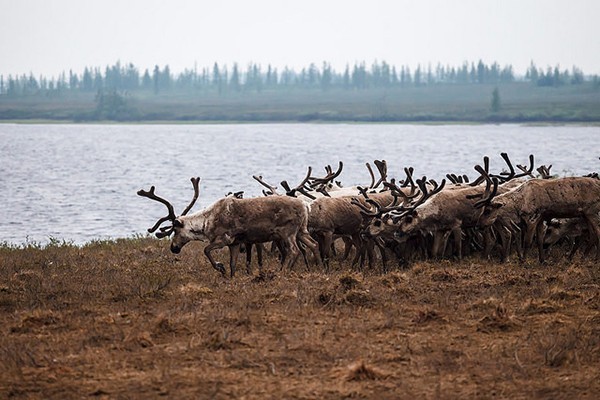
Reindeer graze on the Yamal Peninsula ©Aleksandr Popov, 2012
Climate change has been linked to the worsening of warm weather diseases, such as Dengue, Zika, and Cholera, but unbeknownst to many, there’s plenty of chillier fare on the menu, as well. As temperatures increase, thawing permafrost is releasing a range of previously ice-bound viruses, bacteria, and gases that could soon affect those in the tundra and beyond.
That’s already suspected to be the case in Siberia, where a July anthrax outbreak killed a 12-year-old boy and hospitalized numerous others. Officials believe the outbreak—which affected more than 70 nomadic herders in the Yamal Peninsula—was linked to a thawing of a decades-old reindeer carcass infected with the disease. The last anthrax outbreak in the area was in 1941, according to The Guardian.
“We literally fought for the life of each person, but the infection showed its cunning,” the Yamal governor, Dmitry Kobylkin, was quoted as saying in. “It returned after 75 years and took the life of a child.”
The resurgence of anthrax—as well as other afflictions that could include bubonic plague and small pox—are becoming more likely in the arctic as warmer temperatures begin to thaw permafrost. In the past, animals and humans that died of disease in these areas were buried closed to the surface, since it was difficult to dig deeper graves.
Unfortunately, the viruses and bacteria that killed them lived on and are now essentially being unburied by unprecedented heat in the region, which has been warming at twice the rate of the rest of the world.
"The soil in the Yamal Peninsula is like a giant freezer," Jean-Michel Claverie of the National Center for Scientific Research in France, told NPR. "Those are very, very good conditions for bacteria to remain alive for a very long time."
Bacteria and viruses aren’t the only concern in the peninsula, though. Other hazards lurk beneath the ice, too, including pockets of methane and carbon dioxide.
Decomposing organic matter has resulted huge bubbles of methane and carbon dioxide to collect just beneath the ground (take a look at the surreal phenomenon in this video). In some cases, these bubbles explode, leaving giant methane-laced craters. While those aren’t an immediate threat to worldwide health, the release of large quantities of carbon emissions trapped in permafrost—possibly as much as 200 gigatons by 2100—would significantly increase the impacts of climate change.
While the Yamal Peninsula isn’t the only area where suddenly thawed permafrost is proving dangerous (in Greenland an entire abandoned army base—replete with radioactive water, diesel fuel, and various chemical waste—could threaten oceans), it is a certainly a hotbed of activity at the moment—which could help secure funds to study the situation further. In Russia, as in the United States, support for science is dwindling and attention-grabbing scenarios are more likely to be addressed, said Valery Malinin, an oceanologist from Russia's Hydrometeorological Institute.
“There is less and less attention in our country to science, fewer grants for meteorology,” he told Agence France-Presse. “When there are destructive phenomena we think it would be nice to have prevented them, but as soon as the passions die down, everything is forgotten. Yamal is just a small alarm bell. Nature will continue to challenge us.”
Jolie Breeden is the lead editor and science communicator for Natural Hazards Center publications. She writes and edits for Research Counts; the Quick Response, Mitigation Matters, Public Health, and Weather Ready Research Award report series; as well as for special projects and publications. Breeden graduated summa cum laude from the University of Colorado Boulder with a bachelor’s degree in journalism.